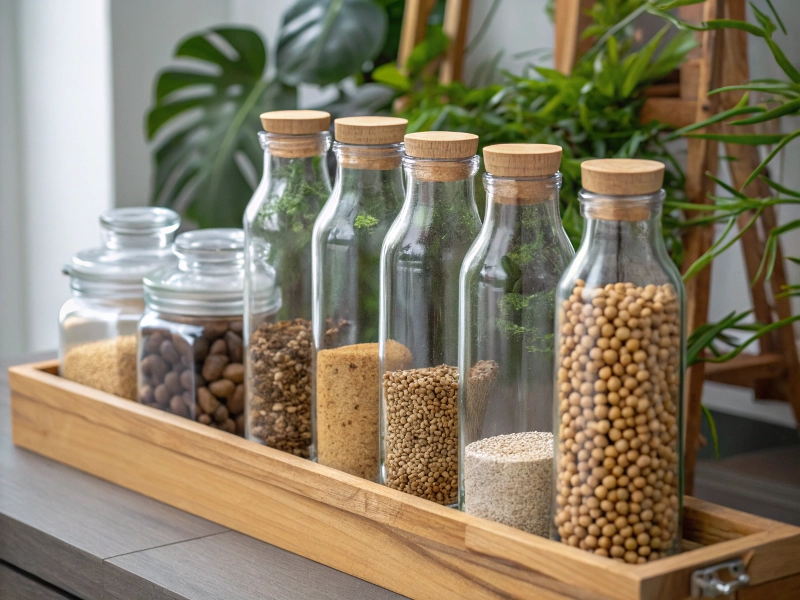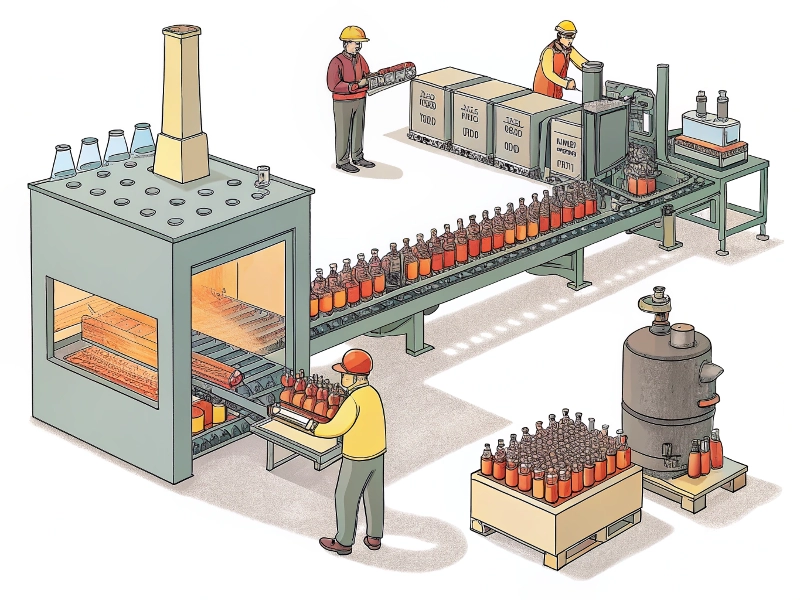Glass is everywhere, and I love using jars for zero-waste pantry storage. But does it break down naturally, or am I just swapping one problem for another? Glass is not degradable but is a sustainable choice due to its infinite recyclability, inert nature, and emerging innovations, making it preferable to plastic for eco-conscious consumers.
Decades of recycling data and cutting-edge tech show glass fits a zero-waste lifestyle. Here’s why:
- Glass resists biodegradation, persisting for thousands of years, but its inertness prevents environmental harm.
- Infinite recyclability saves energy and reduces waste, making glass a cornerstone of sustainable practices.
- Glass outperforms plastic in safety and longevity, despite economic and logistical challenges.
- Emerging innovations, like biodegradable glass, enhance glass’s sustainability potential.
Many think glass, made from sand, breaks down easily. But its toughness raises questions. Why doesn’t glass degrade, and does this hurt the planet?
Why Glass Isn’t Degradable and Its Environmental Impact
Glass feels green in your kitchen. I once chipped a glass bottle, but it still held strong—unlike flimsy plastic. Yet, its durability means it doesn’t biodegrade, sparking landfill worries. Why is glass non-degradable, and how does this affect its eco-friendliness?
Glass resists biodegradation, persisting for thousands of years, but its inertness prevents environmental harm. Made from silica, limestone, and soda ash, glass is built to last, but it’s safe for the environment.
- Glass’s silica-based structure resists microbial breakdown. No bacteria can digest it, unlike food scraps (Southampton University).
- It breaks down into tiny pieces over 4000–20,000 years from wind and water. It’s a slow, natural process (Springer).
- Inertness means it doesn’t release harmful stuff. Unlike plastic’s BPA, glass keeps soil and water safe (ThoughtCo).
- Landfills hold 9.2 million tons of U.S. glass yearly. It takes space but doesn’t pollute (Glass Recycling Foundation, Keep America Beautiful).
- Glass litter (7.2%) can harm wildlife. Sharp shards are risky, though less than plastic’s microplastics (Glass Recycling Foundation, Keep America Beautiful).
Glass’s staying power might seem bad, but recycling makes it a star. Not all glass gets recycled, though. How does recycling keep glass sustainable?
How Glass Recycling Drives Sustainability
Recycling is my zero-waste go-to. Jane, a zero-waste advocate, says, “Recycling glass jars saves me money and feels great.” But only 33% of U.S. glass is recycled, and some types don’t qualify. How does it work, and why does it save 30% energy per ton recycled?
Infinite recyclability saves energy and reduces waste, making glass a cornerstone of sustainable practices. Recycling turns old glass into new, cutting landfill loads.
- Rinse bottles and jars to remove residues. Clean glass ensures quality recycling (Hong Kong CFS).
- Sort bottles and jars from mirrors and glasses. Mirrors have coatings, and glasses hold bacteria, so they’re not recyclable.
- Use curbside or drop-off programs. Apps like RecycleNation find spots in 2025.
- Cash in on bottle bill rebates. States like California pay 5–15 cents per returned bottle.
- Recycle broken glass carefully, if allowed. Some centers take it in sealed boxes, but safety’s key (Hong Kong CFS). Turn old jars into candle holders or herb planters to reuse them (Hong Kong CFS).
Recycling makes glass shine, but its edge over plastic is just as big. Plastic’s cheapness keeps it around, though. Why pick glass, and what’s in the way?
Glass vs. Plastic: A Sustainable Choice with Challenges
My glass water bottle feels safer than plastic ones that get funky fast. In Seattle, a zero-waste café uses only glass, cutting plastic waste by 80%. But plastic dominates stores, despite its harm. Why choose glass, and what’s stopping a full switch?
Glass outperforms plastic in safety and longevity, despite economic and logistical challenges. Glass’s cleanliness makes it a zero-waste favorite, but plastic’s practicality poses hurdles.
- Glass is infinitely recyclable without quality loss. Plastic degrades after 2–3 cycles, often becoming low-grade products.
- Glass is chemically safe, with no toxin leaching. Plastic risks BPA or microplastics, harming ecosystems (YouTube).
- Glass’s smooth surface prevents contamination. Plastic traps food bits, lowering recycle quality.
- Plastic’s low cost and light weight win economically. Glass costs more to make and ship.
- Glass’s fragility limits single-use products. Plastic’s shatter-proof nature suits disposables.
| Aspect | Glass | Plastic |
|---|---|---|
| Recyclability | Infinite, no quality loss | 2–3 cycles, often downcycled |
| Safety | Safe, no toxins | Risks BPA, microplastics |
| Cost | Higher production, shipping | Cheaper to produce, ship |
| Environmental Impact | Inert, 50% global recycling | Persistent, ~9% global recycling |
Glass’s perks are clear, but new tech pushes it further. Traditional glass lasts forever, though. What if glass could vanish naturally?
Innovations Shaping Glass’s Sustainable Future
I saw a dazzling resin glass art piece last month, glowing with colors. It’s a 2025 trend, but traditional glass’s long life clashes with zero-waste goals. What innovations make glass greener?
Emerging innovations, like biodegradable glass, enhance glass’s sustainability potential. New materials and designs make glass eco-friendlier than ever.
- Biodegradable glass decomposes naturally. A 2024 Europe trial used it for packaging, enriching soil.
- Resin glass enhances design applications. Kartell’s 2025 furniture uses it for durability and style.
- Intelligent resin glass adds interactivity. Dimming or touch features save 10% energy in buildings.
- Sustainable resin glass uses renewable materials. It’s degradable, cutting waste in design.
- High-performance glass resists scratches and UV. Skyscraper skylights save 15% energy yearly.
Conclusion
Glass is not degradable, taking thousands of years to erode, but its infinite recyclability, safe nature, and innovative advancements make it a sustainable choice. Unlike plastic, glass avoids toxic messes and supports zero-waste living. Pricier and heavier? Sure, but biodegradable and resin glass are changing the game. Join the zero-waste movement today—recycle one jar or try a DIY planter to cut landfill waste. By 2026, new laws may boost recycling, and glass bottle subscriptions are trending in 2025, so start now!
FAQ
- Is glass biodegradable or compostable? No, it doesn’t break down via microbes, lasting millennia.
- How long does glass take to decompose? 4000–20,000 years through wind and water erosion.
- Can glass be recycled? Yes, bottles and jars recycle endlessly without losing quality.
- Why not switch back to glass if plastic is harmful? Glass is costlier, heavier, and fragile, favoring plastic for some uses.
- Is recycling glass expensive? Most curbside programs are free, but rural areas may need drop-off trips.
- Southampton University, Glass Residual Stress Research (https://www.southampton.ac.uk/engineering/research/projects/characterisation-and-modelling-residual-stress-in-glass.page)
- Thorpe et al., 2025, Springer (https://link.springer.com/article/10.1007/s11367-020-01804-x)
- ThoughtCo, Plastic Bottle Health Hazards (https://www.thoughtco.com/reusing-plastic-bottles-serious-health-hazards-1204028)
- Glass Recycling Foundation, Keep America Beautiful
- Hong Kong CFS, Glass Recycling Guidelines (https://www.cfs.gov.hk/english/programme/programme_rafs/programme_rafs_fc_02_16.html)
- Earth911, Recycling Locator (https://earth911.com/)
- YouTube, Glass vs. Plastic Safety (https://www.youtube.com/watch?v=RD07GkmM2fc)







